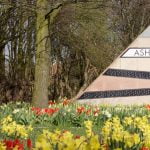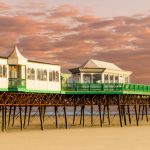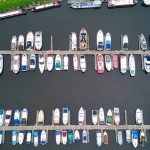A quick guide to Inle Lake, Myanmar
Overview
Inle Lake, the second-largest freshwater lake in Myanmar, is one of the most popular destinations for those visiting the country. It lies in the Taunggyi District of the southern Shan State, which itself is situated in the north-east of Myanmar. While the lake is described as being about 13 miles (21 km) long and 7 miles (11 km) at its widest, large areas of bordering marshland make it difficult to determine exactly where its waters begin. Set in the Shan Hills, Inle Lake has an elevation of around 2,900 ft (880 m). During the dry season, when most people visit, the average depth of the lake is estimated to be a little over 2 m and around 4 m at its deepest point. During the rainy season, these depths will usually increase by about 1.5 m.
Although the lake is not large it contains a number of endemic species of fish and snails. The lake is also on the migratory path of several important species of birds and a sanctuary for other resident species. Accordingly, in 2015, Inle Lake was the first location in Myanmar, and only the 20th throughout the world, to be added to UNESCO’s register of Biosphere Reserves.
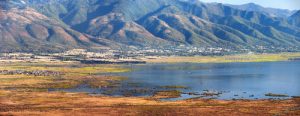
People and Culture
Myanmar is one of Asia’s most diverse nations and its authorities currently recognise no fewer than 135 ethnic groups. The main ethnicity of the people that live around Inle Lake is the Intha people, who migrated to the Lake from Dawei in Myanmar’s far South, during the 18th century. The main reason for leaving behind their former homeland was to escape the relentless conflicts between the Burmese and Thais. There are now an estimated 70,000 Intha who live in the small towns, villages and settlements scattered around the lake, as well as those who dwell on the lake itself, in stilted bamboo houses.
The other peoples that live around the lake are a mix of Shan, Taungyo, Pa-O, Danu, Kayah, Danaw, and the indigenous Bamar. Almost all are inhabitants of the area are Buddhists. Those who not involved in earning a living from some aspect of tourism, largely eke out an existence from farming and/or fishing. Thanks to the world of instant media, the local Intha fishermen are now world-renowned for their unique one-legged rowing style. This involves standing at the back of the boat on one leg, whilst having the other leg wrapped around the oar, which enables them to row while upright. Seemingly, they developed this method of rowing so they could see above the tall reeds and other vegetation that thrive around the lake’s shallows. However, they now practice the method even in open water.
Unsurprisingly, fish is a staple of the local diet, with the native Inle carp (Cyprinus Intha) being the most plentiful. In addition to fishing, the Intha who live on the lake also grow an abundance of fruit and vegetables in large floating gardens. The garden beds are made up of large carpets of vegetation gathered from the bottom of the lake. Once collected, the plant life is then roughly woven into a large mat, which is then anchored by bamboo poles to the lake bed. The nutrient-rich waters of the lake mean that plants in the garden have an endless supply of feed, making the garden areas incredibly fertile. The likes of cauliflowers, tomatoes, cucumbers, cabbages, aubergines, peas and beans are grown all year round. Additionally, like most of the rest of South East Asia, the cultivation of rice is also a significant feature of both the local economy and diet.
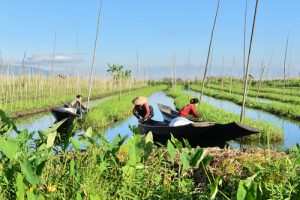
Local Intha people working on the floating gardens
Getting there!
By Air
Heho airport serves the Inle Lake area and you can fly there from Yangon, Bagan and Mandalay, plus a few other remote destinations. It’s about 25 miles (40 km) from Heho to Nyaungshwe but the only way you can do the journey is by taxi, which will cost about US$25. You can usually reserve a taxi when you book your accommodation, which should work out cheaper than hiring one off the street.
By Bus
There are frequent buses operating between Inle Lake and Myanmar’s other main tourist destinations of Yangon (13 hours), Mandalay (10 hours) and Bagan (9 hours). Long bus journey’s in Myanmar nearly always start early in the morning or around mid-evening time. JJ express are one of the country’s biggest and most trusted operators.
From Taunggyi
A number of travellers make the trip to the state capital, Taunggyi before visiting Inle Lake. If you’re travelling from Taunggyi to Nyaungshwe and like the idea of travelling on the cheap or just for the thrill of it, like a local, just head to the city’s main market and take a ‘pickup’. The journey time is a little over an hour and should cost less than US$1.
Entry Fee
There is a government-imposed entry fee of about US$15 (2020) for every foreign tourist entering the Inle Lake area. This fee is often collected at Heho airport when you arrive. If you are travelling by bus, the fee will be collected by an official at a checkpoint set up a few miles from Nyaungshwe. If the bus is full of mostly local travellers, quite often the bus will be waved straight through the checkpoint and won’t stop. After that, there is no one who will check for payment.
Getting Around!
Nyaungshwe is small enough to easily get around on foot, however, you can hire a bicycle for as little as US$ 1 -2 kyat per day, which you can also use to tour the surrounding area. Almost every foreign tourist visiting the area takes a boat trip around the Lake at least once during their stay. The main boarding area is located around the bridge at the west end of Yone Gyi Road.
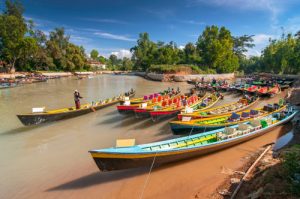
Boats can be hired from the harbour near Yone Gyi Rd
Things to see and do!
Apart from the obligatory boat trip around Inle Lake, there are also plenty of other things to do in the area. Here’s a quick guide to some of the best sights and activities:
Boat trip
Almost all visitors to Inle Lake, especially foreign tourists staying in Nyaungshwe, will take a boat trip at least once during their stay in the area. Every hotel, guesthouse or travel agent in the town will be able to book you a boat. Alternatively, you can take a stroll down to Teik Nan Bridge on Yone Gyi Road, and book a trip yourself with one of the many touts or boatowners that you’ll find congregated in the area. You can book in advance or you might find a boat ready to go there and then. The boats are more or less all the same, which is a longtail motorboat, typical of the type found across South East Asia. You pay for the hire of the boat for the day, making your own bespoke itinerary, so the rate is negotiable. Quite obviously, the further you go and longer the trip, the more you can expect to pay. Boats will generally take 5 or 6 passengers, so if you are on you own or even in a couple, there’s nothing to stop you sharing with other people, if you are all happy with the arrangement.
Apart from Indein Village (see below), the main thing a boat trip around the lake offers is an insight into the various traditional crafts and industry of the area. This involves a stop-off at a number of different workshops on the lake, which would include; silk and other fabric weaving, cheroot making, teak woodworking, production of gold/silver jewellery and trinkets, production of Shan paper and related products, and the floating gardens (see above). You also get the chance to view a typical Intha floating village and the opportunity to dine at a floating restaurant, should you wish. These days, you’re treading a reasonably worn tourist trail, so expect to be led to the requisite gift shop area at each workshop, but there’s no real obligation to buy anything.
Indein Village
The village of Indein (or Inn Thein), meaning ‘shallow lake’, is situated few kilometres west of the south end of the lake. Famed for its large collection of ancient (but mostly crumbling) Shan stupas, the approach to the complex, through marshy grounds with tall reed beds only adds to the surreal, spooky atmosphere. Just beyond the village, one of the sites most notable stupas, Nyaung Ohak , with its elaborate carvings of mythical creatures, can be found. From Nyaung Ohak, you can follow the path uphill to the largest structure of the development and main spectacle, the 17th century Shwe Indein Pagoda. From this vantage point, there are some great panoramic great views, especially across the lake. On the return journey to the jetty you might want to stop off at the small but lively market for a browse.
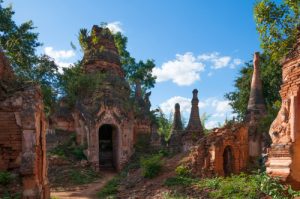
The Nyaung Ohak complex of ruined stupas at Indein
While most people usually visit Indein by boat, as part of a longer trip, it’s also possible to reach the village by taxi or bicycle.
Red Mountain Estate
The Red Mountain Estate is one of only two vineyards in the whole of Myanmar. Situated in a picturesque valley that wouldn’t look out of place in the South of France, it’s located within easy cycling distance (75 mins) of Nyaungshwe. You can take a short tour to view the wine-making operation which is run about every couple of hours but doesn’t seem to be a hard and fast timetable. However, the main event is the wine-tasting session, where you can sit amongst your fellow travellers, inside or outside, soaking up the atmosphere and spectacular views, whilst trying out a few different vintages. There’s also a half-decent restaurant serving local and western-style food, and the wine itself is surprisingly (IMHO) quite good. Better still, the whole event will only set you back a few dollars.
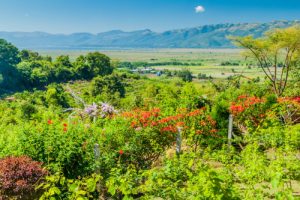
A view from the Winery at Red Mountain Estate
Mingala Market
The busy market is located at the entrance to the town and operates on a daily basis. Locals stream to the market in the mornings when fish from the lake, and fresh produce from the floating gardens, are brought in by local traders.
Khaung Daing Hot Springs
The Hot Springs are located about ½ mile from the northwest corner of the lake and about 5 miles from Nyaungshwe, close to the village of Khaung Daing. You can reach the Springs quite easily by road, with many visitors choosing to do the journey by bicycle. The complex is quite basic and would probably be described by many as being a little rundown. There’s a couple of small hot springs that emerge out of the ground but these are poorly marked. The Spring hot waters are channelled to a few primitive-looking bathhouses and a small swimming pool. You can rent a towel, as well as buy snacks and beverage on site – but that’s about it! If you arrive with few expectations, you won’t be disappointed. You might well find that the scenic bike ride to the Springs itself is the best part of the day.
Trekking
Inle Lake is a popular starting point for a number of treks in the area, with the most popular being the 2-4 days (depending on route taken) trek to Kalaw. There are also a number of day hikes and overnight treks that stick to the hilly areas surrounding the lake. The latter can often involve an overnight stay in a Pa-O village. The other popular walk is the 3-day trek to Kakku, towards Taunggyi, where the main point of interest is a collection of some 2,500 stupas. Trekking on your own is definitely not recommended and should always be undertaken under the supervision of an experienced guide. Expect to pay in the region of US$ 20 – 30 per person per day for overnight treks and about 50% less for a day trip.
Hot Air Ballooning
While hot-air ballooning is much more popular at Bagan, it’s also possible to make a balloon trip at Inle Lake. The ballooning season runs from November to March. While spectacular views and once-in-a-life experience can be guaranteed, it doesn’t come cheap. The ride, lasting around 45 minutes, will set you back around US$ 350 but may be a little more or a little less, depending on the numbers of your fellow voyagers. You can book a balloon trip online, or alternatively, through one of the specialist travel shops in Nyaungswhe.
Cycling
Cycling is one of the most popular things for visitors to do around Inle Lake. Almost every shop or café seems to rent out bikes as a sideline, therefore it’s very cheap. To hire a standard (sit up and beg style) bike only costs about US$ 1 – 2 per day, but mountain bikes will be a bit more. If you do decide on a day or more cycling be sure to take plenty of water and sunscreen, as the sun can be fierce even in the cool season. Apart from the almost obligatory visits to the Red Mountain Estate (see above) and the Hot Springs, the other main thing to do is to make stop-offs at the various small villages and religious monuments, scattered at the along the road. It’s not possible to circumnavigate the lake by road, but you take a 30-minute ferry ride across the lake from the village of Khaung Daing on the west side to Maing Thauk on the east side (or vice versa), to make the best possible effort. There are noteworthy religious buildings and monuments not far from both locations.
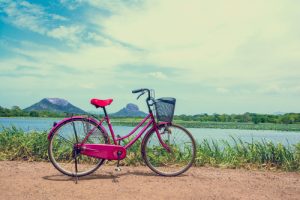
Cycling is a cheap and popular method of travel
Phaung Daw Oo Pagoda and Festival
Phaung Daw Oo Pagoda, located in Ywama village the shores of Inle Lake, is one of the most revered religious sites in the whole of the Shan State. The pagoda houses five small highly venerated Buddha objects. Over many years the figures have been subject to continuous gilding are now so heavily gold-leafed that their original form has been lost. Nonetheless, their existence is celebrated annually by the inhabitants around the lake.
The Phaung Daw Oo Pagoda Festival is an 18-day celebration that usually takes places in October, though exact dates vary from year to year in accordance with the Lunar Calendar of Myanmar. During the festival, four of the five Buddha images are placed on a decorated royal barge and then transported around the lake. The barge is pulled by a number of longboats that employ the aboriginal one-legged rowing technique, with all rowers being dressed in traditional ceremonial attire. The procession stops off at 14 different villages, where the images are displayed at their main monastery overnight for villagers to pay homage. Finally, the holy images arrive back in Nyaung Shwe, where the gathered masses pay their respects and celebrate the occasion. The festival culminates with dance shows and other spectacles, but the main event is the boat race, where participants employ the mandatory one-legged rowing technique.
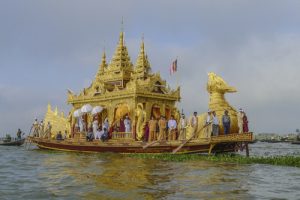
The Royal Barge leads the procession around the Lake
Eating and Drinking
While there are plenty of places to eat in Nyuangshwe, you won’t find a Michelin star restaurant. However, there are numerous places serving up decent Burmese and Shan food, with set meals generally working out the best value. It’s also possible to find restaurants that serve basic Thai food as well as essential western fare such as burgers, chips (French fries), pizza, pasta, etc. If you’re just looking for a snack or a cheap breakfast, you’ll find good quality street food at Mingala Market and between 6 – 9 am and at Yone Gyi Road Night Market between 5 – 9 pm.
Despite having decent numbers of backpackers passing through Nyuangshwe on a regular basis, it’s a little surprising that there is no real bar scene. Locals mostly drink at the town’s low-end beer bar-restaurants, while foreign tourists tend to enjoy a few tipples where they eat dinner. Cocktails can be particularly strong, with measures of alcohol, typically being double, treble or possibly quadruple the standard measure of that of the UK. With a cocktail usually only costing about US$2 -3, it makes a night on the town a cheap affair.
Where to stay?
here are a good number of luxury resorts situated around the edge of Inle lake for those with relatively deep pockets. However, the vast majority of the visitors to the Inle area tend to stay in the town of Nyuangshwe. Situated close to the north end of the lake, Nyuangshwe has dozens of accommodation joints, which range from budget backpacker guesthouses to boutique style hotels. During peak season, mid-November to January, demand for accommodation in Nyuangshwe can often outstrip supply, so be sure to book well in advance if you aim to travel within that period. And, prices can be considerably higher in peak season than in low season for the same accommodation. Most tourists travelling to Inle Lake will only stay for 3 or 4 nights. A rough guide to prices per night for 2 adults sharing is:
Guesthouse: US$ 20 – 70
Hotel: US$ 70 – 110
Luxury Hotel: US$ 150 – 250


